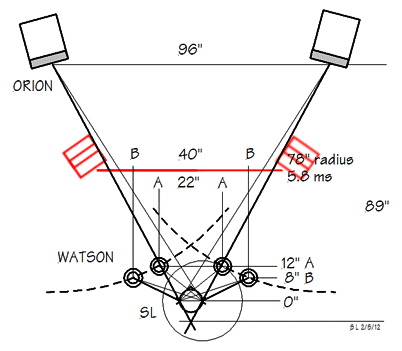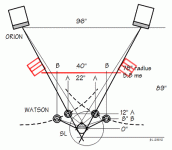Hi,
I agree, basically a non-axis symmetrical waveguide is needed.
Perhaps the best of these was the old JBL 2346 Horn/Waveguide as found in the original JBL Everest. It goes beyond simple pattern control to a pattern that actually stabilises stereo image over wide range of lateral displacement of listening position from the "hot seat"... Introduced in 1985.
EVEREST
Ciao T
Now this is something you could sell to me
What is the alternative?
The one-speaker stereo setup? Yes I would like to build that one day!
That, or almost any other non conventional stereo system
Why do we need alternatives ? To learn more about psychoacoustics !
For example, Watson can teach us what does it mean for perception of stereophonic records if low freq ITD could be reproduced in a small room acoustic spaces. If one sticks only with a conventional stereo setup with normal speakers in a typical small room, he may never learn what to expect what is possible.
- Elias
That, or almost any other non conventional stereo systemDiyaudio threads already contain a number of them
Why do we need alternatives ? To learn more about psychoacoustics !
For example, Watson can teach us what does it mean for perception of stereophonic records if low freq ITD could be reproduced in a small room acoustic spaces. If one sticks only with a conventional stereo setup with normal speakers in a typical small room, he may never learn what to expect what is possible.
- Elias
I've always suspected that ICTD reproduction is best in a free field
By the way, sticking with normal speakers, using a room equalizer and/or treating the room can have the same effect.
I'm all for trying different things but advocating "different" just to be different reminds me of this:
An externally hosted image should be here but it was not working when we last tested it.
Last edited:
only a subset of measurements
Polars are a subset of measurements. And being that they are irrelevant as such without the precise knowledge of the room the speakers will be placed in.
One can only have a belief the speakers are placed in a room of an assumed kind.
- Elias
Polars are a subset of measurements. And being that they are irrelevant as such without the precise knowledge of the room the speakers will be placed in.
One can only have a belief the speakers are placed in a room of an assumed kind.
- Elias
I can't speak for you but I know the room I place my speakers into.
I can't speak for you but I know the room I place my speakers into.
The problem is that no one else knows your room which disables the usage of polars as the universal truth.
The speaker and the room much match. If the speaker is given (bought) design a room for it (cumbersome !). If the room is given (living room) design a speaker for it (more easier).
- Elias
If the room is given (living room) design a speaker for it (more easier).
...or choose from a range of available designs that fit your requirements, but this would require manufacturers to provide meaningful data. One of those metrics would be polar data. Unfortunately no manufacturer provides that kind of data. That's the reason for my little rant. Earl is close but he doesn't show vertical response either. Danley provides even balloon data but only 1/3 smoothed. Genelec...
From my perspective designing a speaker is not an easy task. Of course you can put some chassis in a box and be amazed that sound is coming out of it but that's not the kind of quality I'm looking for.
Last edited:
This is OT, but here is Nathan vertical:
3D3A Lab at Princeton University
3D3A Lab at Princeton University
An externally hosted image should be here but it was not working when we last tested it.
Here one can read about ITD in real rooms.
Localization of sound in rooms. V. Binaural coherence and
human sensitivity to interaural time differences in noise
http://www.ncbi.nlm.nih.gov/pmc/articles/PMC3003727/pdf/JASMAN-000128-003052_1.pdf
Note: Their example rooms are medium sized, not exatly same size like European living rooms. For example the smallest of their room is 2-3 times my living room. Despite of this feature some results may be extracted and found useful, I believe.
- Elias
Localization of sound in rooms. V. Binaural coherence and
human sensitivity to interaural time differences in noise
http://www.ncbi.nlm.nih.gov/pmc/articles/PMC3003727/pdf/JASMAN-000128-003052_1.pdf
Note: Their example rooms are medium sized, not exatly same size like European living rooms. For example the smallest of their room is 2-3 times my living room. Despite of this feature some results may be extracted and found useful, I believe.
- Elias
What kind of setups are you thinking of?
Well, let's operate on the assumption that there are high-q cancellations in the initial wavefront from any direct radiator speaker. These can be comb filtering, out of phase room reflections, etc.
These exist, but typically the easiest to measure is the coherent floor notch.
Now say you arrayed some 100-1kHz mids around the room (assuming you have a speaker, as you do, with good pattern control above 1k)
With Watson, these high q notches are mitigated by drivers close to you (nearfield), so they're able to act as fill to any of these notches. The major downside is "head in a vice" and needing a prominent if small second pair of speakers with a delay.
Alternatively, one could use 2 100-1k mids per channel, placed to be equidistant from you as the mains, at golden ratio placement (or any other non-multiple) relative to the tweeter. These would be lower in level, 15-20dB than the mains, so lobing and siginificant interference with the primary wavefront would be less of a concern, while giving you some fill in any higher-q notches via source distribution.
Because they'd be placed aligned with the mains, they would not require the delay, and because the level demands are so low, they could be a very simple thing- perhaps even just nude drivers with a big coil and resistor setup, run off the same amp as the mains. I think that most people could accept a little rearward "ambience" if it were 15dB down, even with very controlled directivity monopoles.
While this tread has moved on to things that are not so much "Watson", the real "Watson' page has almost daily updates.
WATSON-Stereo_Expansion_Loudspeakers
WATSON-Stereo_Expansion_Loudspeakers
Joachim,
I know what you mean about getting tired defending the concept. I would like to benefit from your experience though! Are you still using a Watson setup? What have of found to be the best way to do it? I'm thinking of making a Watson using Linkwitz's design, and again, wondering if it will really make a difference to music listening. Seems like it will, given SL's comments and your own experience, but just thought I wold check in with you personally before trying it.
Cheers,
Devin
I know what you mean about getting tired defending the concept. I would like to benefit from your experience though! Are you still using a Watson setup? What have of found to be the best way to do it? I'm thinking of making a Watson using Linkwitz's design, and again, wondering if it will really make a difference to music listening. Seems like it will, given SL's comments and your own experience, but just thought I wold check in with you personally before trying it.
Cheers,
Devin
I build my own ones. I will publish a picture. It is a mini linesource with 2 Visaton. I set them up very low so that they radiate against my stomach.
The interesting thing is that you can listen to them alone and get quite an amazing soundstage, deep, wide and high and well focussed, totally free from the speakers.
I think i found a new nearfield setup that has advantages when space is a premium.
I use them on and off and found that some people like the effect and others get disturbed especially when the highs are not rolled away, so as Watsons they should not emit much treble.
The interesting thing is that you can listen to them alone and get quite an amazing soundstage, deep, wide and high and well focussed, totally free from the speakers.
I think i found a new nearfield setup that has advantages when space is a premium.
I use them on and off and found that some people like the effect and others get disturbed especially when the highs are not rolled away, so as Watsons they should not emit much treble.
I have moved my dipole speakers nearer to my listening position. Compared to the Watson situation they are at the red positions:

I found that I can have much of the claimed Watson advantages without the added hassle. When I leave the reverberation dominated distance by moving from reclined seating to a forward leaning position, the acoustic scene narrows from 90+° to 60°, sound images get nailed at their position and details abound.
I wonder when SL will abandon the Orions altogether and listen solely to some speakers at the Watson position

I found that I can have much of the claimed Watson advantages without the added hassle. When I leave the reverberation dominated distance by moving from reclined seating to a forward leaning position, the acoustic scene narrows from 90+° to 60°, sound images get nailed at their position and details abound.
I wonder when SL will abandon the Orions altogether and listen solely to some speakers at the Watson position
Attachments
I do listen in the nearfield since the early 80th. When i was with Audio Physic i even trained my dealers and importers worldwide to do this in the shop and on shows. That was the "No Loss of fine Detail" concept. You can still find my setup method on our american website CANALISAUDIO.COM, editted by Allen Perkins. Also Martin Colloms has it in his book and there is an interview with Malcolm Haksford that Jan Didden did that has my original drawing. Some dealers and magazines still have my old gaffer tape on the floor 
- Home
- Loudspeakers
- Multi-Way
- Linkwitzlab "Watson"
